Decapods
Decapods are an order of crustaceans which includes crayfish, crabs, lobsters, and shrimp. Decapod means “ten footed”; most decapods have ten walking legs, but may have other appendages for uses such as feeding or swimming. Most decapods are scavengers, and will consume anything they find on the sea floor. True crabs account for over half of all described species, with shrimp and the group Anomura making up most of the remaining species. Decapods have a hard exoskeleton called a carapace, which covers their whole thorax and head. They live in a variety of habitats, including marine, freshwater, brackish and terrestrial systems.
The Pacific Northwest is home to hundreds of species of decapods, and we have a variety of different specimens in our collection!
Shrimp
Shrimp have a semitransparent, flattened body, a flexible abdomen and a fanlike tail. Their appendages are all modified for swimming, and they are more likely to swim than to walk along the seafloor. They have long, whip-like antenna. Shrimp are found in all oceans in both shallow and deep water, and are also found in many freshwater lakes and streams. Many species are incredibly important as food, and are caught by both recreational and commercial fisherman. Shrimp range greatly in size, from a few millimeters to 8 inches in length. When threatened, shrimp use a strategy called a “tail flip”, in which they quickly swim backward by flexing the abdomen and flicking their tail. Shrimp can prey on a range of small plants and animals, though most are scavengers. Female shrimp lay large quantities of eggs, ranging from 1,500 to 14,000 eggs depending on the species. The eggs are attached to the female’s swimming legs, and are carried with her until they hatch.

Pacific Prawn
(Pandalus platyceros)
Pacific prawns are commonly trapped by both recreational and commercial fisherman in BC.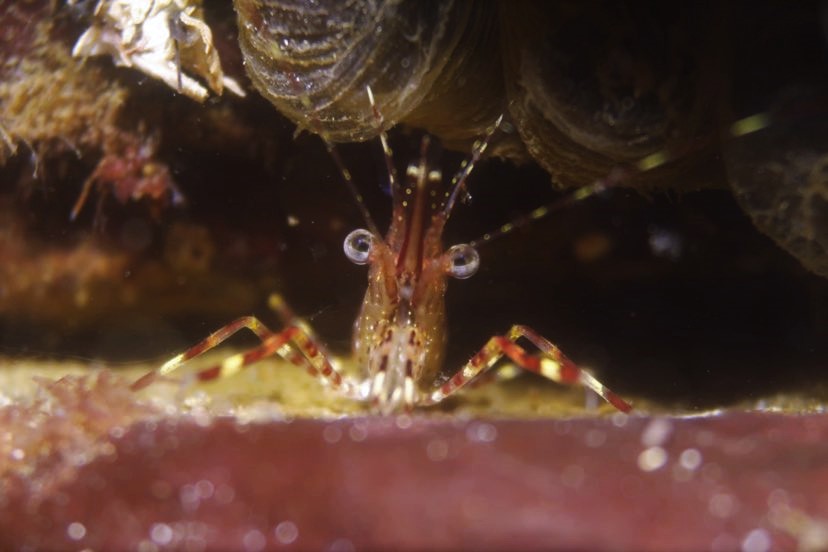
Dock Shrimp
(Pandalus danae)
Shrimp are a common sight at many popular dive sites on Vancouver Island, and are most active at night.
Check out Britannica for more information.
True Crabs
Crabs are covered with a thick chitinous exoskeleton that they shed and regrow as they grow. They are armed with a single pair of claws called chelae, and five pairs of well-developed walking legs. It is this fifth pair of developed walking legs that distinguishes true crabs from other crustaceans that are commonly called “crabs”. Anomurans, which are a group of crustaceans that look very similar to crabs, only have four pairs of walking legs. Crabs are found living in marine, freshwater and terrestrial ecosystems across the globe. Crabs vary in size from the pea crab, at just a few millimeters across, to the Japanese spider crab, which is over 13 feet across. Crabs are extremely active animals, often seen scurrying around on the beach. Due to the placement of their legs, almost all crabs move sideways. They exhibit complex behaviors, including communicating by drumming or waving their chelae. Crabs can also be extremely aggressive towards one another. Males will fight each other over mates, and on crowded shorelines they will fight over hiding holes.
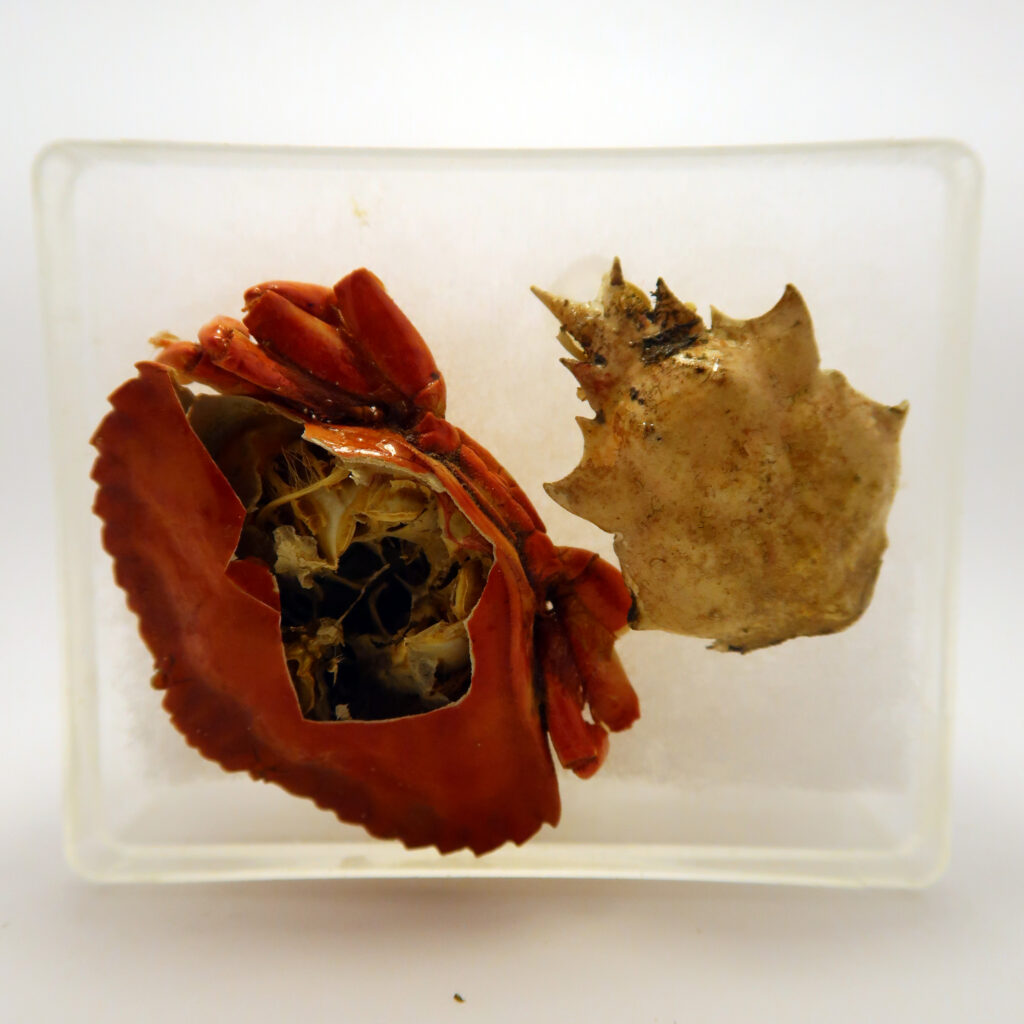
Red Rock Crab (left) & Kelp Crab (right)
There is wide variation in carapace shape within the true crabs.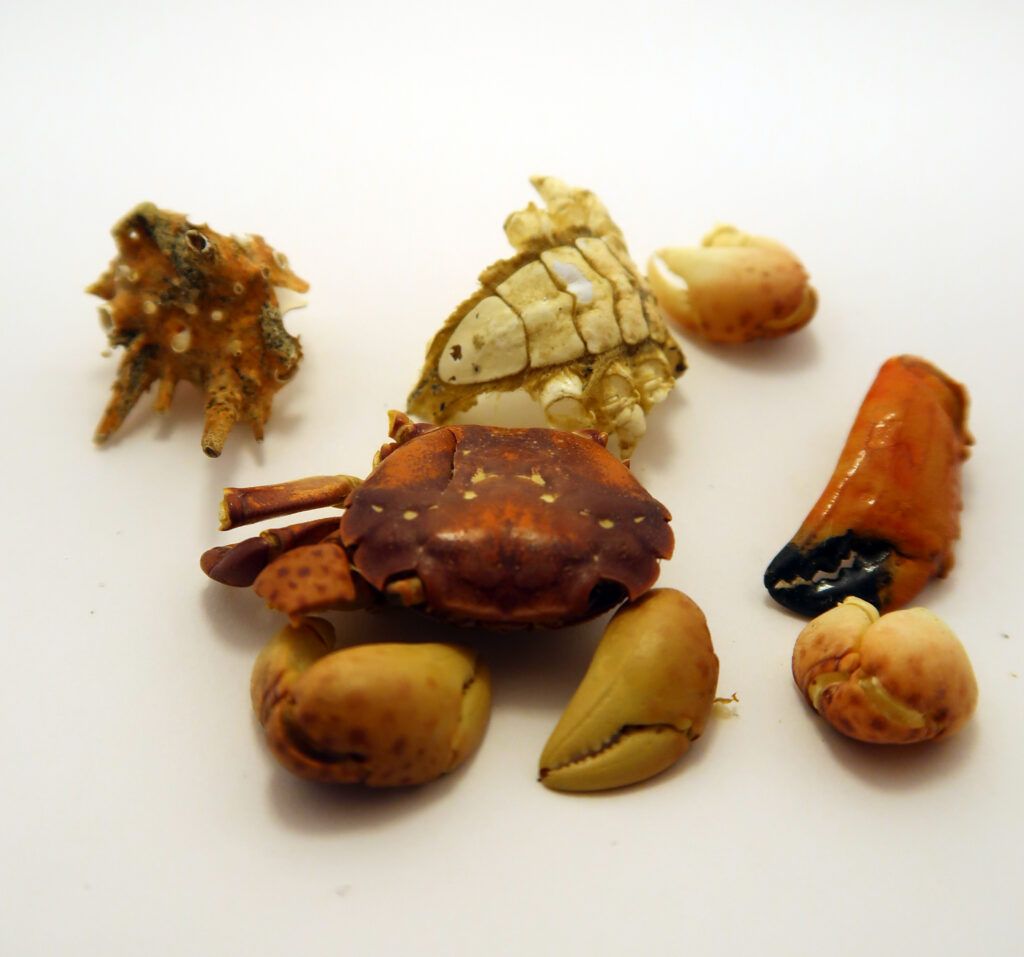
Purple Shore Crab
(Hemigrapsus nudus)
Purple shore crabs have spots on their pincers and lack hair on their legs.
Red Rock Crab
(Cancer productus)
Red rock crabs have black tipped pincers that can deliver a powerful pinch!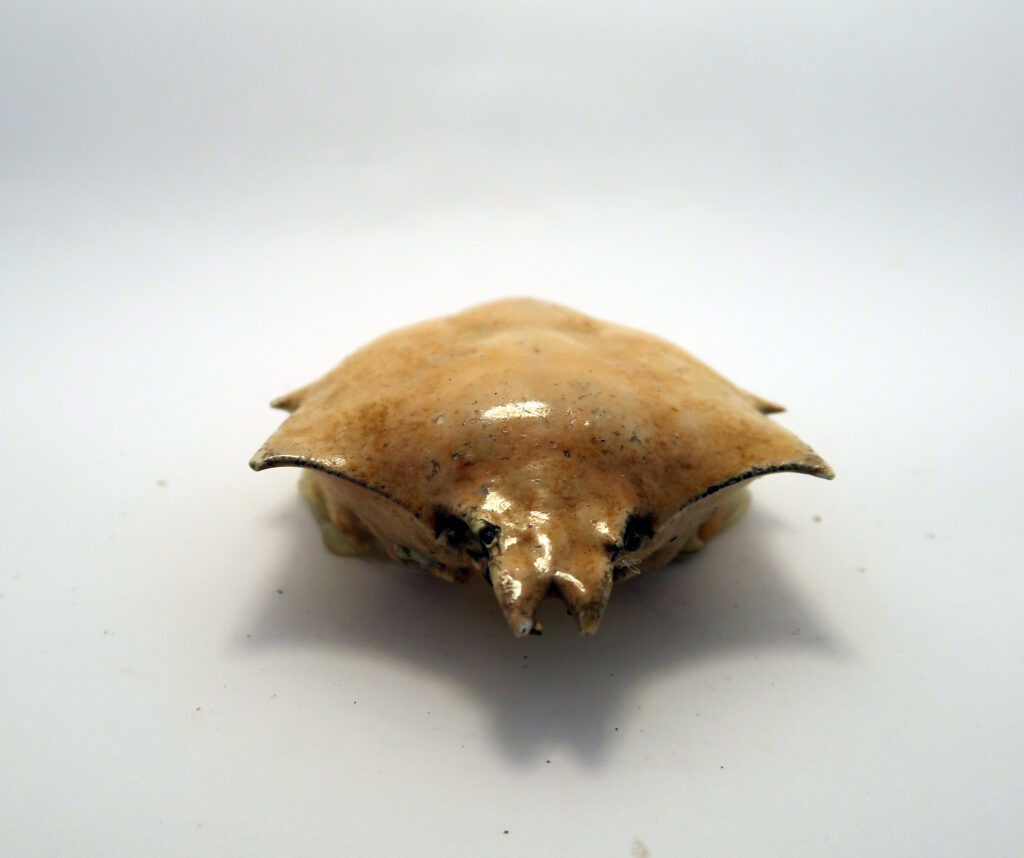
Kelp Crab Carapace
Kelp crabs have a close association with different types of algae, and typically have similar colours to algae for camoflage.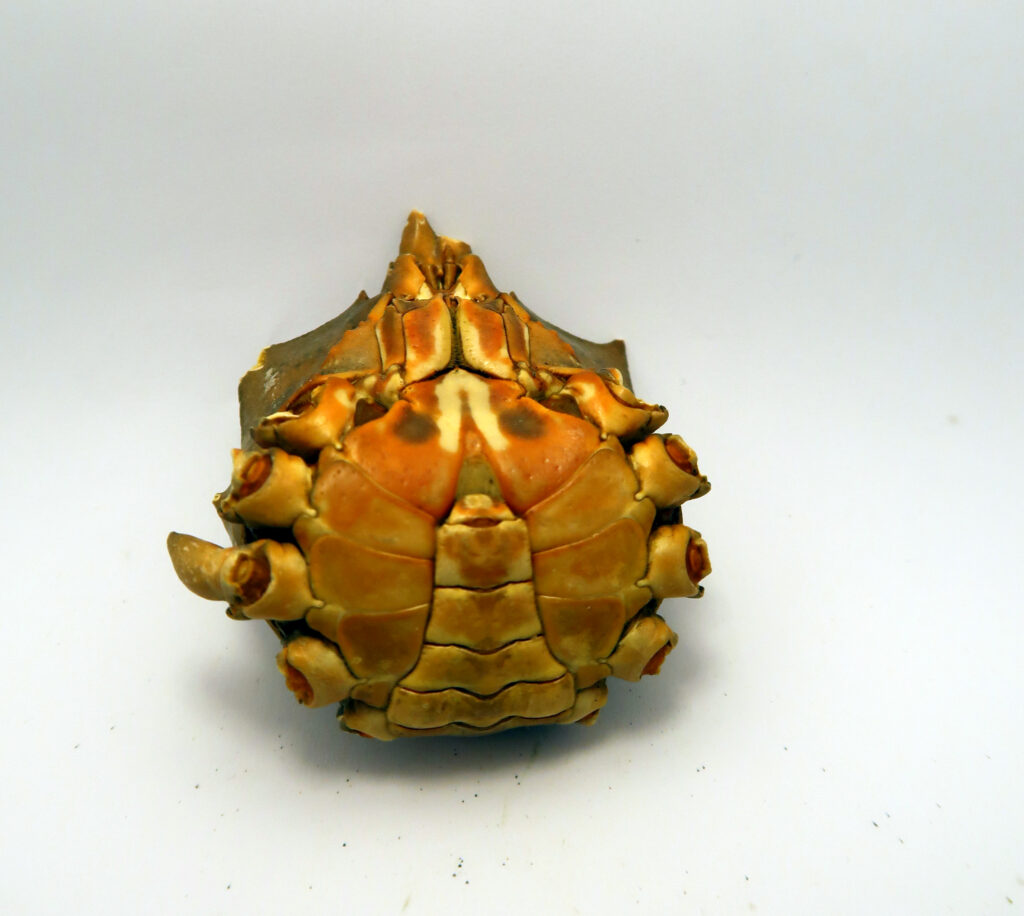
Kelp Crab Abdomen
You can tell the sex of a crab based on the shape of it’s abdomen. This crab has a pointed abdomen, indicating that it is a male. Females have a rounded abdomen.
For more information check out E-Fauna BC.
King Crabs
King crabs belong to the family Lithodidae, which contains approximately 120 species. King crabs are not true crabs as they lack a fifth pair of walking legs. King crabs are found across the globe, but are particularly prevalent in cold water so they are only found at great depths in tropical waters. They are typically large crabs and often the target of commercial fishing operations. The most recognizable of the king crabs in BC is the Puget Sound king crab. They are large, brightly coloured, and covered in bumps. They are protected on the Washington side of the Salish Sea, but not the Canadian side. Puget Sound king crabs feed primarily on sea urchins, other echinoderms, and anemones.

Puget Sound King Crab
(Lopholithodes mandtii)
A defining characteristic of the Puget Sound king crab is the blunt, rounded bumps on the exoskeleton.
Puget Sound King Crab
(Lopholithodes mandtii)
Puget Sound king crabs are extremely brightly coloured!
Check out Central Coast Biodiversity for more information.
Hermit Crabs
Despite their name, hermit crabs are not true crabs, since they only have three sets of walking legs, rather than five. Hermit crabs lack a hardened exoskeleton on their carapace, and utilize the discarded shells of other organisms for protection and shelter. They have many adaptations to allow for life in a shell. They have an asymmetric abdomen which allows them to fit snugly into a shell, and one of their chelae is larger than the other, and is specially shaped to block the shell’s opening. Hermit crabs are found across the globe, typically in shallow sandy areas. Hermit crabs use their second and third pairs of legs to walk, and the fourth and fifth are modified to grip onto the inside of the shell.
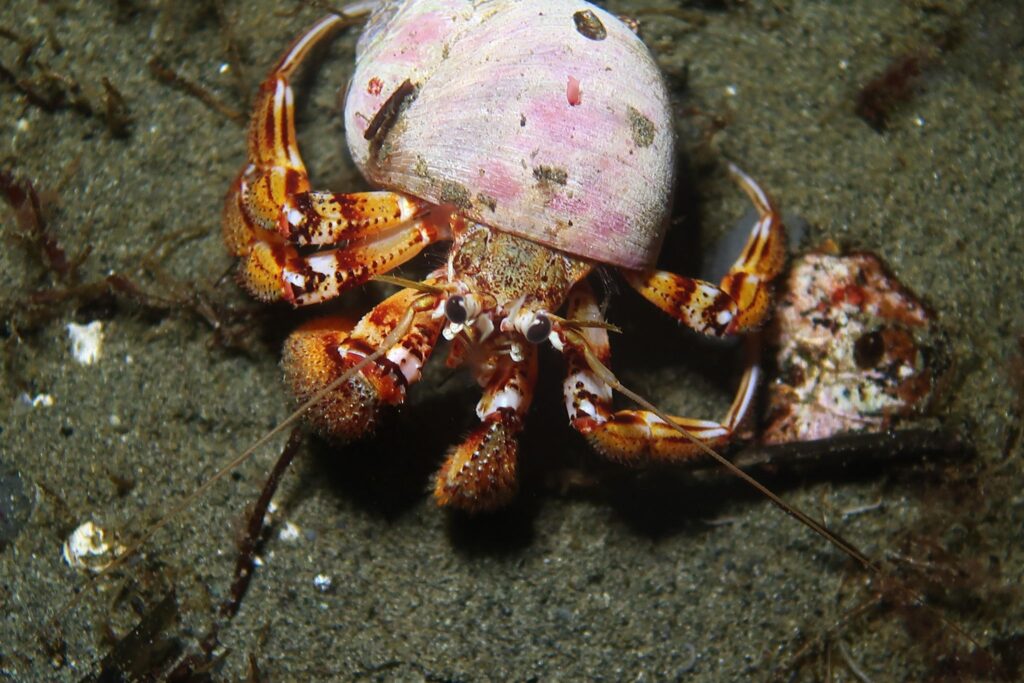
Black-eyed Hermit Crab
(Pagurus armatus)
Hermit crabs rely on the shells of mollusks to protect their soft bodies. This crab is using an old moon snail shell.
Hermit Crab in Moon Snail Shell
Hermit crabs often have growths of algae or other organisms on their shells.
For more information check out Britannica.


